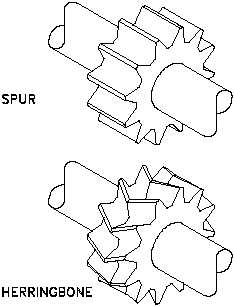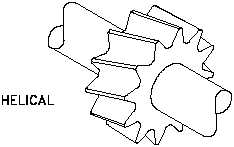Pumps
DOE-HDBK-1018/1-93
POSITIVE DISPLACEMENT PUMPS
With the large number of teeth usually employed on the gears, the discharge is relatively
smooth and continuous, with small quantities of liquid being delivered to the discharge line
in rapid succession. If designed with fewer teeth, the space between the teeth is greater and
the capacity increases for a given speed; however, the tendency toward a pulsating
discharge increases. In all simple gear pumps, power is applied to the shaft of one of the
gears, which transmits power to the driven gear through their meshing teeth.
There are no valves in the gear pump to cause friction losses as in the reciprocating pump.
The high impeller velocities, with resultant friction losses, are not required as in the
centrifugal pump. Therefore, the gear pump is well suited for handling viscous fluids such
as fuel and lubricating oils.
Other Gear Pumps
There are two types of gears used in gear pumps
Figure 15 Types of Gears Used In Pumps
in addition to the simple spur gear. One type is
the helical gear. A helix is the curve produced
when a straight line moves up or down the
surface of a cylinder. The other type is the
herringbone gear.
A herringbone gear is
composed of two helixes spiraling in different
directions from the center of the gear. Spur,
helical, and herringbone gears are shown in
Figure 15.
The helical gear pump has advantages over the
simple spur gear. In a spur gear, the entire
length of the gear tooth engages at the same
time. In a helical gear, the point of engagement
moves along the length of the gear tooth as the
gear rotates. This makes the helical gear operate
with a steadier discharge pressure and fewer
pulsations than a spur gear pump.
The herringbone gear pump is also a
modification of the simple gear pump.
Its
principal difference in operation from the simple
spur gear pump is that the pointed center section
of the space between two teeth begins
discharging before the divergent outer ends of
the preceding space complete discharging. This
overlapping tends to provide a steadier discharge
pressure.
The power transmission from the
driving to the driven gear is also smoother and
quieter.
Rev. 0
ME-03
Page 23



